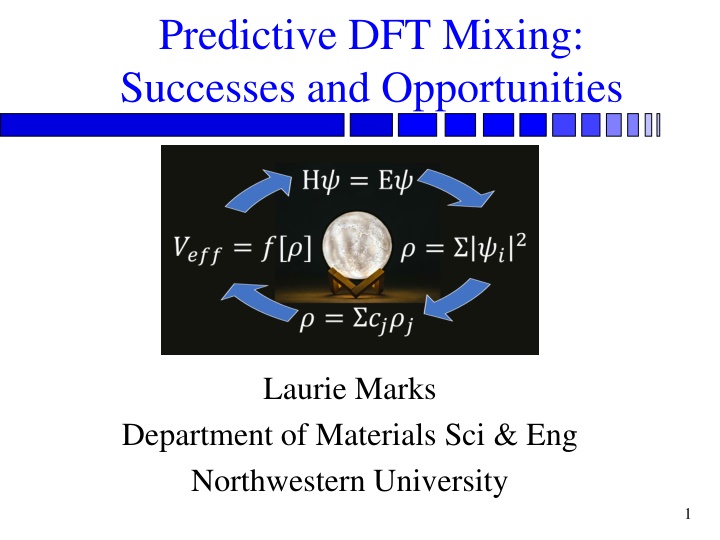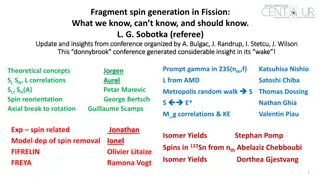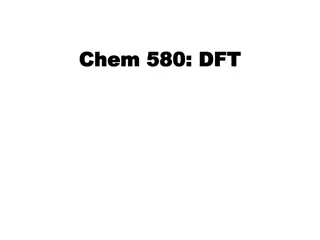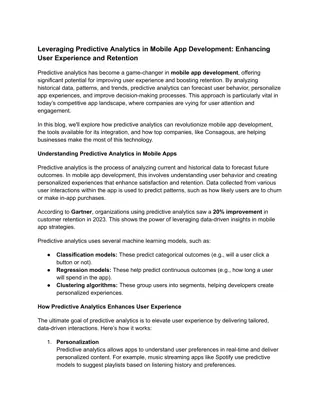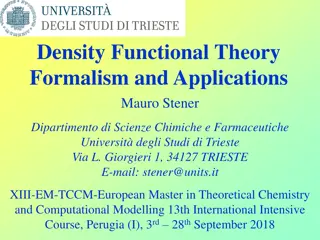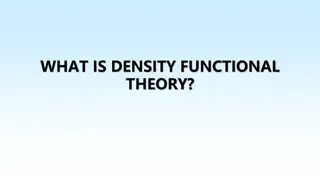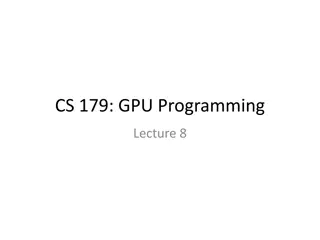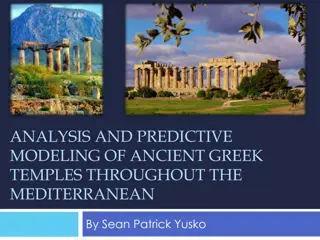Predictive DFT Mixing: Successes and Opportunities in Materials Science
Laurie Marks from Northwestern University discusses the successes and opportunities in predictive DFT mixing, focusing on the advancements in density functional theory, fixed-point solvers, and the approach taken in physics and pragmatism. The presentation includes insights on the applications of DFT in chemistry, materials science, and physics, highlighting the critical role it plays in computational studies and supercomputing.
Download Presentation

Please find below an Image/Link to download the presentation.
The content on the website is provided AS IS for your information and personal use only. It may not be sold, licensed, or shared on other websites without obtaining consent from the author.If you encounter any issues during the download, it is possible that the publisher has removed the file from their server.
You are allowed to download the files provided on this website for personal or commercial use, subject to the condition that they are used lawfully. All files are the property of their respective owners.
The content on the website is provided AS IS for your information and personal use only. It may not be sold, licensed, or shared on other websites without obtaining consent from the author.
E N D
Presentation Transcript
Predictive DFT Mixing: Successes and Opportunities Laurie Marks Department of Materials Sci & Eng Northwestern University 1
Acknowledgements Peter Blaha Russel Luke TU Wien U. G ttingen 2
Caveat 1 I have a British sense of humor I am not a mathematician, and do not publish in SIAM I can code adequately (Dunning-Kruger) I am 67% experimental, 33% theory I do physics/chemistry/materials science and have been called many things (some nice) 3
Caveat 2 History according to DFT & Math are (very) different We tried to marry these, see Marks & Luke arXiv:0801.3098v1 2008 Referee thought it was too math chatty , so we had to condense it 4
Context Wien2k, standard benchmark for DFT Algorithms I will talk about are in code used by > 3,000 groups around the world Calculations that range from seconds to weeks on > 128 cores >20,000 calculations, used in > 1,000 refereed papers Copied to three other codes 5
Overview What is (and is not) DFT What is needed for the mixer (fixed-point solver) How this has been approached (physics and pragmatism). Much that goes further than math literature (sorry). Predictive approach Since I come from a different community, my approach is different 6
What is DFT? Density Functional Theory Solve the quantum mechanics for tens to thousands of atoms Fundamental to many areas of current chemistry, materials science and physics One of the major killer of electrons on supercomputers 7
Fixed Point cycle Functional derivative of Energy Start with r(r) Mix F(r r(r)) & r r(r) Calculate Veff (r) =f[r(r)] SCF cycle 2| ) r r ( = r Compute ( )) | ( 1 F 2 + = i r r r Solve { ( )} ( ) ( ) V eff i i i 2 i E F Solves a variational energy by a fixed-point method, implicit minimization 8
General Structure Density contains 103 to 106 components No gradients plausible Fortunately the eigenvectors/values are much, much smaller (10-1000) Often converges in 20-40 iterations Iff well posed, the stationary point is a variational minimum of the energy, so has good properties 9
But.. The term DFT is a misnomer Saying I used DFT is like saying that I solved a math problem There are hundreds of flavors of differing complexity, different models for the potential For some problems particular models are not variational minima 10
Jacobs Ladder Accuracy Complexity Numerics Stability Conditioning Speed J. P. Perdew et al., J Chem Phys 123, 062201 (2005) 11
Balance issues Not a simple grid with terms of equal importance Relative importance varies with problem Can have mixed variables (in Wien2k only) Densities, gradients & atomic positions Constraints (Lagrangian additions to fixed point) 12
Aside: general case in Wien2k There is no need to limit to just a fixed point ??(??) = ?(??) ?? Generalization ??(??,??) = (?(??) ??,??) Positions ??, pseudo-gradient ?? converges to a true gradient of the energy at the solution. Proposed in 1983 bv Bendt & Zunger, failed then and with DIIS (Kresse, priv comm) 13
Math issues There are cases with multiple fixed points There are cases where there is no downhill route from certain densities to the solution At the solution properties are good unpredictable otherwise Radius of convergence etc. changes with problem, details unclear Global minimum with atoms as well 14
Numerical issues Algorithms involve numerical integrations/differentiations stability and conditioning errors Some codes are more equal than others, e.g. break symmetry boundary conditions Variables often effectively single-precision Not a well researched topic (most codes have been written by physicists/chemists) 15
Transparency issues All approaches require an inverse how is rarely mentioned (and regularization) Codes can have rubber bands to hold them together (Wien2k did 15 years ago) They are not always written to be transparent Can have undisclosed variables (sometime not deliberate) 16
Physics issues The fundamental character can change discontinuously, to illustrate Problem starts as steam Then condenses into water Ends as ice There might be a storm/lightning in the mix This cannot be ignored in the math or algorithm. 17
Phase Transitions: Can change discontinuously Electronic configuration of F(r) in the second step as a function of the size of the first Pratt step for an Fe atom, with the 4s occupancy within the muffin-tins in black (x10) and the 3d in red 18
Analogy: water running downhill Start with r(r) Mix F(r r(r)) & r r(r) Calculate Geff (r) =f[r(r)] SCF cycle 2| ) r r ( = r Compute ( )) | ( 1 F 2 + = i r r r Solve { ( )} ( ) ( ) V eff i i i 2 i E F Solves a variational energy by a fixed-point method, implicit minimization 19
Flowing downhill can be simple Red River 20
Not so simple Mississippi Many wiggles, but no hard walls 21
Problem Changes Starts in the mountains Lake Powell Grand Canyon Down to sea not! 22
What is needed Fixed-point algorithm that can solve for all reasonable problems. (Really dumb ones are impossible.) No user adjustable parameters Solves for all different flavors from 10 to 103 atoms, good to bad conditioning, stiff to soft, all levels of Jacob s ladder Works for users who know little 23
Caveat One of the most common questions on DFT lists is: My calculation won t converge, please help 24
How to solve? General approach: Using available information to find solutions Simple approach: 25
Historical perspective New point ?(??) Define a residue ??= ?(??) ?? Simplest is linear ??+1= ??+ ??? Slow, and what is ? ? (user choice) Pratt method often works if the user chooses right 26
More history Initially people tried the standard Broyden method (1965) it did not work Sequential Broyden, fair (Srivastava, 1984) Better, multisecant (Johnson 1988) ??+1= ??+ ???? The coefficients from L2 (LS) solution. Some LS are more equal than others. Different regularization & conditioning 27
General form ??= ?? ?? ; ??= ?? ?? ? = ??+ ?? ??+1+ ??+1 ?? ??+1+ Form a matrix for s & y values The key question is how to construct the solution, for which there are more than a few issues. Marks & Luke, 2008 28
General form Predicted step 1??= ?? ?? ??= ?? Unpredicted step, greed ?? ??= ?? ???? General form ??+1= ??+ ????+ ???? 29
General form Predicted step 1??= ?? ?? ??= ?? Unpredicted step, greed ?? ??= ?? ???? General form ??+1= ??+ ????+ ???? 30
Issue 1: Unpredicted step No information available Must be controlled If too large, simplex gradients are unreliable Implicit trust, i.e. increase if improving enough It is hard to know what enough is 31
General form Predicted step 1??= ?? ?? ??= ?? Unpredicted step, greed ?? ??= ?? ???? General form ??+1= ??+ ????+ ???? 32
General form Expand using prior histories (Secant) ??= ?? (?? ??= ?? (?? ??= 1 ? ??+ ??? ? = 0 is conventional Broyden (soft) ? = 1 DIIS, Anderson, MSEC (stiff) Regularized pseudo-inverse (SVD), (Max Sing)*10-4 ???) 1 ?? ???) 1 ?? ? ? 33 Marks 2013
Issue 2: Scaling How to treat the previous steps? Sequential (Broyden) or multisecant (DIIS, Simplex)? As is, with different magnitudes? All my tests support a simplex gradient Broyden DIIS Simplex 34
Issue 3: what form? ???) 1 ?? ? ??= ?? (?? ??= 1 ? ??+ ??? ? = 0is conventional Good Broyden, most greedy, may diverge, soft case ? = 1 DIIS, Anderson, Bad Broyden, least greedy, may stagnate (different scalings ), stiff case 8-16 memories (not critical) 35
What is a greedy algorithm? A greedy algorithm takes decisions on the basis of information at hand without worrying about the consequences. In many cases greed is good , but not always. Example: make 41c with 25c, 10c, 4c coins Optimum solution: 25+4x4 Greedy solution: start with 41c, use largest reduction 25c Remainder 16 10c Remainder 6 4c Remainder 2 36
Ansatz: inspired by optimization ??= 1 ? ??+ ??? Search up for largest ? where ?? have source eigenvalues ???does not Stable Unstable 37
Issue 4: Predicted ? = ??+ ?? ??+1+ ??+1 ?? ??+1+ What about the higher-order term? The linear model (predicted step is only valid for small enough steps) What is small enough needs a trust region Surprisingly I don t think any code except Wien2k has trust regions for DFT Tensor method (untested) 38
Algorithms Work Versions, in use ~1 year before paper 2008 DOI:10.1103/PhysRevB.78.075114 controlled unpredicted step no more user input. Generalization of multisecant methods 2013 DOI:10.1021/ct4001685 implemented the general form, which is needed to avoid stagnation. (Solves simultaneously for atomic positions & density, global minimum.) 39
Not enough Problems: It is hard (to impossible) to know when a step is good enough or bad enough to adjust trust regions as residue is not always well scaled Sometimes can stagnate Sometimes can start badly Can still diverge 40
Predictive mixing (2021) Use best values for the last step DOI: 10.1021/acs.jctc.1c00630 41
Reminder: general form Predicted step & residue ??= ?? 1??= ?? ?? ?? ?= ???? Unpredicted step, residue greed ?? ??= ?? ????= ?? General form ??+1= ??+ ????+ ???? ? 42
What we should have use Predicted step, find ? that minimizes ||?? 1 ? ???? 1|| then ??= (?? 1+ ? )/2 Unpredicted step find that minimizes ||?? 1 ? ???? 1|| then ??= (?? 1+ ? )/2 For trust radius, use ||?? 1 ? ????|| then ??= (?? 1+ ? )/2 General form, bounded by size ??+1= ??+ ????+ ???? ? ? 43
Standard additions For a really bad step, recalculate along direction and discard new point (don t contaminate simplex gradients) If a little bad, add to matrices & recalculate SVD inversion with regularization Start conservative No user parameters except a couple that they think work but don t (they will fiddle) 44
Does it work? Simple case, bulk MgO Greed/Trust start low, then rapidly increase 45
More complex: atoms+density ????????? MSR1: Predictive MSEC: =0 MSGB: =1 DIIS: =0, different scaling ??/???? DIIS/MSEC don t converge MSGB is noisy (too greedy) 46
Statistics Ration of iterations to converge of predictive approach versus best (by search) of greed for 36 cases (blue), and 4 which never converged in red 47
Current status A detailed search can often find parameters as good at the cost of doing 10 times or more as many calculations It (and earlier versions) have survived the acid test novice users Follows the math No rubber bands 48
Known unknowns What is the right way to choose ??= 1 ? ??+ ??? L2, L1, Kullback-Leibler or other metrics? Tensor methods? Predictive approach in other DFT codes? Can it be used for other acceleration tools? Adaptive windowing in anger? Are their Wolfe conditions? 49
